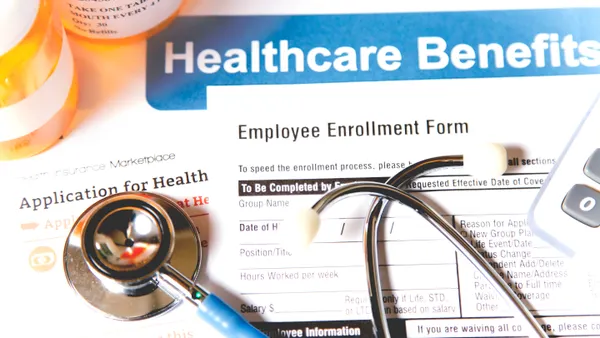Dive Brief:
- The share of out-of-pocket healthcare costs paid by employees within employer-sponsored health plans increased from 17.4% in 2013 to 19% in 2019, and the rise of high-deductible health plans appears to be driving the trend, researchers at the Employee Benefits Research Institute said in a statement Monday.
- Researchers found that plan design played a role in whether costs increased. Those in non-high-deductible plans, such as preferred provider organizations and health maintenance organizations, saw decreased or stable costs during the same time frame. While most enrollees did not see out-of-pocket spending rise significantly, those who were high users of care and those with certain medical conditions did, EBRI said.
- Out-of-pocket spending for outpatient services grew faster than for inpatient services, while expenditures for prescription drugs declined. EBRI utilized data from the IBM Marketscan Commercial Claims and Encounters Database, encompassing more than 45 million patients.
Dive Insight:
As with many goods and services, healthcare has not been immune to inflationary pressures. U.S. health systems faced a combination of rising supply and labor expenses in recent months, according to Healthcare Dive, even as patient volumes have increased. As a result, providers are likely to pass on increased costs to commercial insurers during upcoming contract negotiations, Fierce Healthcare reported last week.
But from the employer perspective, employee benefits programs — including health benefits — remain a key component of talent management in a difficult hiring market, according to a McKinsey & Co. report from May. The consultancy also found that many employers have turned to HDHPs, among other strategies, as a way to address rising costs.
Yet increasing employee deductibles creates a “fundamental tension” between employers’ dual goals of securing workers’ well-being and controlling costs, according to EBRI.
“On the one hand, employers are more frequently implementing financial wellness programs as a means to improve their employees’ financial wellbeing,” Jake Spiegel, research associate at EBRI, said in the statement. “On the other hand, in an effort to wrangle health care cost increases, employers often turn to raising their health plan’s deductible, potentially offsetting the positive impact of any financial wellness initiatives.”
In their report, EBRI’s researchers also noted the role that health savings accounts, which may be offered in conjunction with a HDHP, may play in balancing increased out-of-pocket costs. Those enrolled in an HSA-eligible HDHP may be able to cover those costs using HSA contributions made by themselves and their employers. A previous EBRI report highlighted the role that pre-deductible coverage of chronic condition medications may play in HSA-eligible plans.
Aside from increasing patient deductibles, there are a variety of other cost-saving healthcare measures employers may seek. An executive for insurer NFP previously told HR Dive that these options can include care navigation services, virtual care options and value-based care arrangements, among others.














